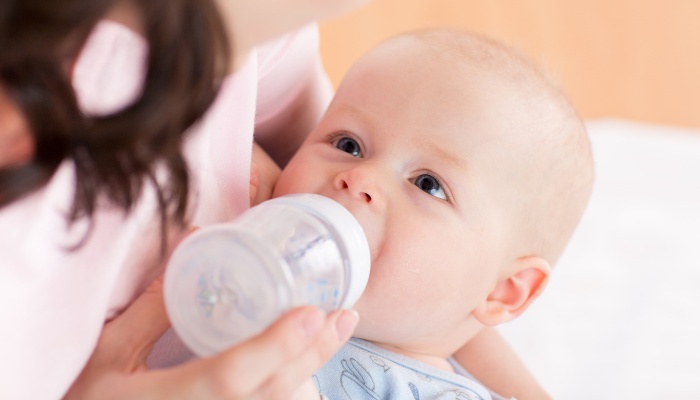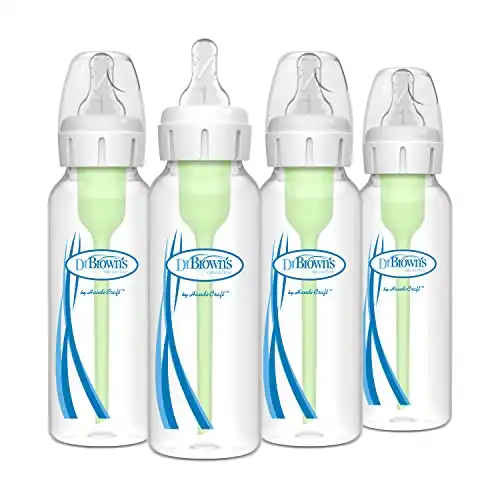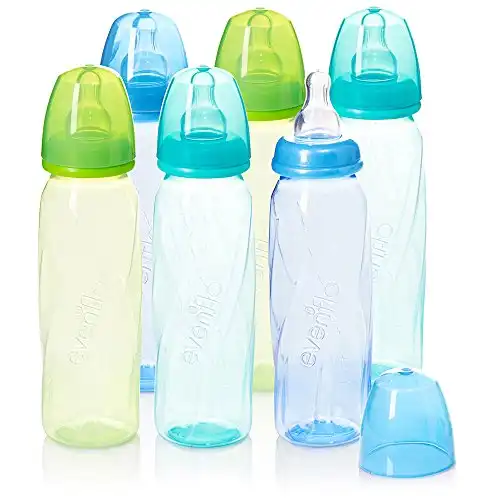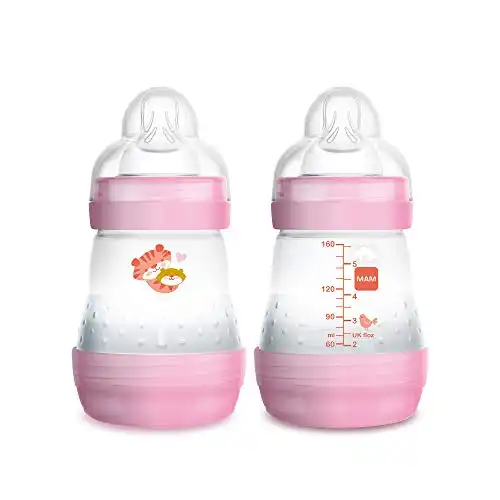If you are a new mother or currently expecting, and you are researching the various types of bottles that are suitable for your newborn, it is highly probable that you have encountered vented bottles.
Also known as anti-colic bottles, these bottles are advertised to reduce gas, fussiness, and colic symptoms in babies.
Before you hit “Add to Cart” or purchase these bottles, you might be wondering if they are worth trying.
Vented baby bottles have been proven to reduce gas, fussiness, and other colic symptoms in newborns and young infants. Compared to standard bottles, they provide a more comfortable feeding experience for babies and encourage healthy growth and development for little ones.
Let’s take a look at what makes vented bottles different from traditional baby bottles and why you might want to have some on hand for your little one.
Understanding Vented Baby Bottles
There are two things that can make bottle feeding a challenge: air and a vacuum inside the bottle.
Let’s take a look at how vented bottles can help you overcome these unwanted guests in your baby’s bottle.
How Do Vented Baby Bottles Work?
If a bottle-fed baby does not hold the nipple correctly or suck efficiently, air enters the bottle, and a partial vacuum develops as the baby drinks.
This can make it difficult for the baby to “pull” out milk, leaving him hungry and frustrated, not to mention that the baby is likely sucking in a lot of air, which can cause colic and gas.
Venting systems allow a constant stream of air to enter and exit the bottle as the baby sucks.
While it sounds counterintuitive, the airflow prevents a vacuum from forming, prevents air bubbles from forming in the milk, and consequently reduces the risk of colic and gas.
Vented bottles have a unique design. They have a built-in, internal vent that resembles a straw. This vent keeps the nipple full of milk and prevents air from accumulating in it.
Are Baby Bottle Vents Necessary?
Not all babies need vented bottles. Some babies have a good latch with a strong and efficient suck that prevents too much air from entering the bottle as they drink.
However, vented bottles are extremely helpful for babies who suffer from colic or those that do not have a very strong suck or effective latch on the nipple.
Some parents opt to use non-vented bottles with silicone twist pouches inside to minimize the risk of their child ingesting too much air while drinking.
The twist pouches eliminate the need for a vent because they collapse as the baby drinks and no air enters the pouch.
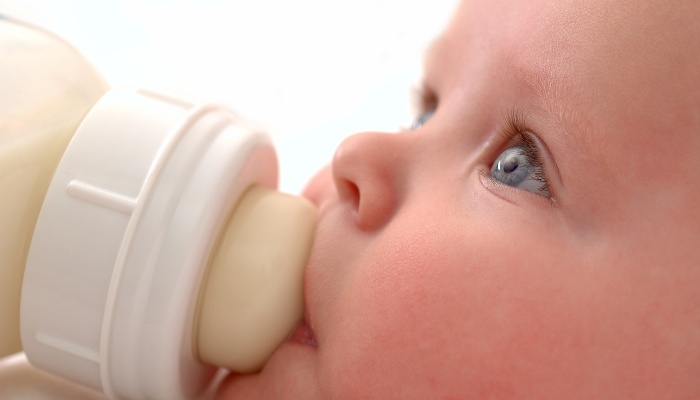
Benefits of Vented Baby Bottles
There are lots of good reasons to use a vented bottle, including:
- Reduces the risk of colic, spit-up, burping, gas, and ear infections that can be caused by ingesting too much air while drinking.
- Baby can feed more comfortably.
- Recent studies show that vented bottles can help preserve the nutrients (vitamins and lipids) in milk and protect them from air bubble oxidization.
Disadvantages of Vented Baby Bottles
The only real downside of vented baby bottles is the extra work they create for you with all of the extra parts to clean. Also, if not assembled properly, they may leak.
When To Use a Vented Baby Bottle
Any baby can use a vented bottle! However, they are typically most beneficial for babies who seem upset after feedings and have a lot of gas.
If you suspect that your baby has colic or is ingesting too much air while drinking, switching to a vented baby bottle is a good place to start.
How To Sterilize Vented Baby Bottles
You can sterilize vented bottles just like you would traditional bottles. Disassemble the bottle, and place all of the parts in a sterilizer.
Don’t have a sterilizer? No problem. A pot and boiling water will do the trick! Cover all of the disassembled parts with water and boil for 5 minutes.
When To Stop Using Vented Baby Bottles
It is recommended to keep using the internal vent until you see the following signs of improved feeding habits:
- Baby can sit up on his own.
- They have begun solid foods.
- They are not showing signs of colic, fussiness, gas, or reflux after drinking.
Vented Baby Bottles: Top Mom-Approved Options
When it comes to choosing bottles, the plethora of options can make it feel daunting and overwhelming.
It ultimately comes down to trial and error and figuring out which bottle works best for your baby.
However, to begin your search, give these tried and true options a try first.
Dr. Brown’s Natural Flow Anti-Colic Options+
Dr. Brown’s bottles are known for their internal vent system that is clinically proven to reduce colic. The bottles provide vacuum-free feeding, preserve nutrients, and aid in your baby’s digestion.
The breast-like nipple shape on the bottle encourages a proper latch and eases the transition from breast to bottle.
These bottles can also be used without the internal vent, so there is no need to buy new bottles whenever your baby no longer needs the venting system.
Philips Avent Anti-Colic Baby Bottles With AirFree Vent
Designed to reduce colic, gas, and reflux. AirFree vent keeps the nipple full of milk, not air.
These bottles have been rated #1 for the best anti-colic bottle and are a mom favorite.
They have all of the same perks as the Dr. Brown’s bottles, but fewer parts make for an easier cleaning and sterilizing process.
Evenflo Feeding Premium Proflo Vented Plus
These bottles have a one-piece venting system, meaning they do not have an internal vent like other anti-colic bottles, but they still keep the air bubbles out of the bottle and out of your baby’s tummy.
With only three pieces, they are easy to assemble and disassemble for quick and effortless cleaning.
MAM Easy Start Anti Colic Baby Bottle
If your baby bounces between the breast and the bottle, this may be a good option for you.
Its nipple is designed to mimic breastfeeding, and the venting system reduces the risk of colic, gas, and fussiness.
Related Questions:
How Often Should I Sterilize Baby Bottles?
The CDC recommends sterilizing feeding parts daily, especially if your baby was premature or has a weakened immune system due to illness.
Daily sterilizing may not be necessary for older babies as long as feeding parts are cleaned carefully after each use.
Does Air in Bottle Cause Colic?
Colic is not necessarily caused by air in the bottle, although ingesting air can worsen colic symptoms in babies. Colic has several contributing factors including:
- Underdeveloped/developing digestive system.
- Imbalance of healthy bacteria in the digestive tract.
- Food allergies or intolerances.
- Overfeeding, underfeeding, or infrequent burping.
- Family stress or anxiety.
Closing Thoughts
I hope that answers any questions you may have about vented bottles!
If you are still on the fence, my advice would be to get a bottle that has a removable internal vent. That way you have the option to use it as a vented bottle or a traditional bottle.
Charlynn is an educator and mom to fraternal boy/girl twins. She loves learning through the experiences she has with her littles and using her knowledge to help other moms as they embark on the journey of motherhood.

